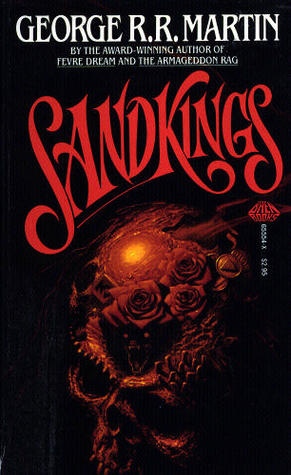I’d like to share some thoughts on a spectacular piece of fiction called Sandkings by George R. R. Martin.
It’s a short science fiction/horror story about a guy, Simon Kress, who is a remarkably bad person. The story begins with him purchasing a number of strange pets and turning them against one another for entertainment.
While reading it today, I found myself in awe of George’s ability to reveal a character’s personality without flat-out telling me that “Simon Kress was vile.”
Simon Kress lived alone in a sprawling manor house among the dry, rocky hills fifty kilometers from the city. So, when he was called away unexpectedly on business, he had no neighbors he could conveniently impose on to take his pets.
The carrion hawk was no problem; it roosted in the unused belfry and customarily fed itself anyway. The shambler Kress simply shooed outside and left to fend for itself; the little monster would gorge on slugs and birds and rockjocks. But the fish tank, stocked with genuine Earth piranha, posed a difficulty. Kress finally just threw a haunch of beef into the huge tank. The piranha could always eat each other if he were detained longer than expected. They’d done it before. It amused him.
When reading this passage, I am totally engrossed. Kress’s little dilemma is appealing, but I believe it’s his way of thinking that hooks me.
… he had no neighbors he could conveniently impose on to take his pets.
Could you imagine someone conveniently imposing their pets on you for the weekend? No thanks… Consider the difference it would make had the sentence read “Kress had neighbors, but hated to burden them with his pets on such short notice.”
Each example presents a very different character. In the first, he is a jerk. In the second, he is considerate. Most new writers won’t allow you to make these assumptions. They simply state the facts and move on. Doing so detracts from the narrative. Don’t tell me Simon Kress is a jerk, show me how he is one.
The shambler Kress simply shooed outside and left to fend for itself.
The image of Kress shooing this thing outside was very comical to me. The door swings open, out pops the shambler (whatever that is), and the door slams shut. Very Pixar like. All of that action from one simple verb: Shoo.
A good action verb can go a long ways. Many times we forget just how creative our readers are. We often feel the need to spell things out and list actions step by step. In result, we slow down the pacing and risk losing our readers.
Take this for example:
The ghost could be seen standing outside his window. Frightened, the man got up out of bed and ran for the door.
That’s 22 words! Yikes. Let’s write the same sentence using strong action verbs instead:
Outside his window, the ghost appeared. With a yelp, the man leapt from his bed and bolted.
Not only is this sentence shorter, but the stronger verbs paint a much more frantic picture for the reader. Plus, we see that he is frightened by his actions, so there’s no point in saying it in the sentence.
The piranha could always eat each other if he were detained longer than expected. They’d done it before. It amused him.
This is just icing on the cake for me. This is where the reader goes… Oh man, this guy’s worse than I thought!
It’s also a perfect example of show vs. tell. It’s disturbing how easily this choice is made. You can almost see Kress smirking at the thought of it.
So, in eight sentences we get a very clear picture of who Simon Kress is. I don’t know the color of his eyes or how ripped his chest is, but that’s okay. Eye color was never much of a hook for me anyway.
As seen above, Simon Kress is unsettling at best. We know this from the start, and are fascinated to watch this little seed of evil grow in him as the story progresses. If you haven’t read it, please do. It’s a terrific story that is sure to leave you satisfied (if not a little disturbed).
Here’s a prompt for you. In ten sentences or less, present a character struggling with a decision. Do this for two or three completely different characters using the same dilemma. How does each one resolve the issue? What does their solution reveal about them?
Thanks for reading and, as always, good luck.
